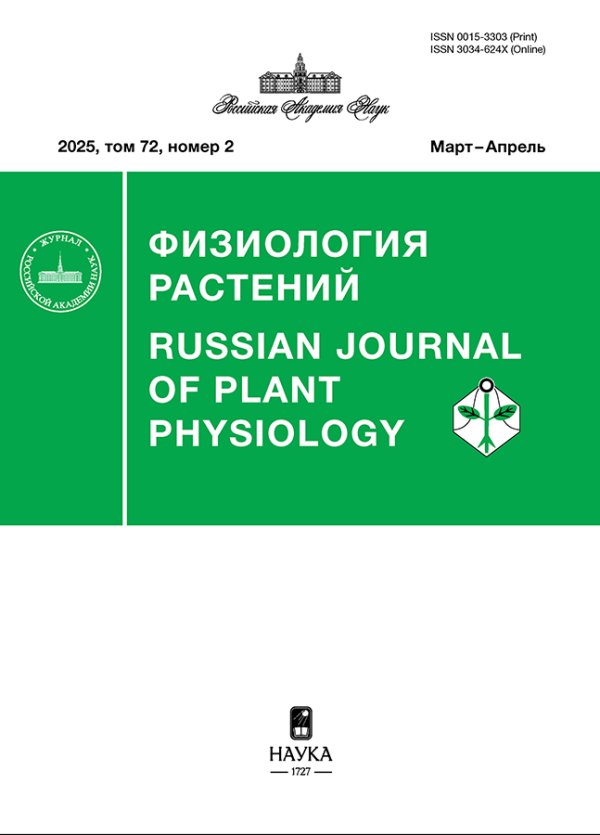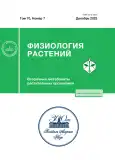Изменчивость состава биологически активных веществ в цветках и листьях Achillea asiatica Serg. в зависимости от региона произрастания
- Авторы: Курченко В.П.1, Сушинская Н.В.1, Чудновская Е.В.1, Тарун Е.И.1, Шабуня П.С.2, Лодыгин А.Д.3, Хрусталева И.А.4, Куприянов А.Н.4
-
Учреждения:
- Белорусский государственный университет
- Институт биоорганической химии Национальной академии наук Беларуси
- Северо-Кавказский федеральный университет
- Кузбасский Ботанический сад
- Выпуск: Том 70, № 7 (2023)
- Страницы: 758-764
- Раздел: ЭКСПЕРИМЕНТАЛЬНЫЕ СТАТЬИ
- URL: https://journals.rcsi.science/0015-3303/article/view/233775
- DOI: https://doi.org/10.31857/S0015330323601139
- EDN: https://elibrary.ru/ZQTYVH
- ID: 233775
Цитировать
Полный текст
Аннотация
Проведено сравнительное исследование состава биологически активных веществ метанольных экстрактов из цветков и листьев Achillea asiatica Serg. аборигенной флоры Сибири и Казахстана, произрастающих в различных регионах России (Кемерово, Хакасия) и Казахстана. Использование газовой хроматографии с масс-спектроскопией для анализа экстрактов из цветков и листьев показало, что существуют значительные отличия в составе и содержании моно-, сескви- и кислородсодержащих терпеноидных соединений, которые связаны с регионом произрастания. Антиоксидантная активность экстрактов из цветков A. asiatica исследованных образцов значительно выше, чем в экстрактах из листьев. Эффективность антиоксидантного действия экстрактов определяется преимущественно фенольными соединениями, которые не относятся к терпенам. Проведенные фитохимические исследования трех образцов A. asiatica из различных регионов произрастания показали значительную изменчивость состава биологически активных веществ и их антиоксидантной активности. При заготовке лекарственного сырья это может привести к различной фармацевтической активности травы A. asiatica.
Ключевые слова
Об авторах
В. П. Курченко
Белорусский государственный университет
Email: kurchenko@tut.by
Республика Беларусь, Минск
Н. В. Сушинская
Белорусский государственный университет
Email: kurchenko@tut.by
Республика Беларусь, Минск
Е. В. Чудновская
Белорусский государственный университет
Email: kurchenko@tut.by
Республика Беларусь, Минск
Е. И. Тарун
Белорусский государственный университет
Email: kurchenko@tut.by
Республика Беларусь, Минск
П. С. Шабуня
Институт биоорганической химии Национальной академии наук Беларуси
Email: kurchenko@tut.by
Республика Беларусь, Минск
А. Д. Лодыгин
Северо-Кавказский федеральный университет
Email: kurchenko@tut.by
Российская Федерация, Ставрополь
И. А. Хрусталева
Кузбасский Ботанический сад
Email: kurchenko@tut.by
Российская Федерация, Кемерово
А. Н. Куприянов
Кузбасский Ботанический сад
Автор, ответственный за переписку.
Email: kurchenko@tut.by
Российская Федерация, Кемерово
Список литературы
- Turkmenoglu F.P., Agar O.T., Akaydin G., Hayran M., Demirci B. Characterization of the volatile compounds of eleven Achillea species essential oils from Turkey and biological activities of the essential oil and methanol extract of A. hamzaogluii Arabacı & Budak // Molecules. 2015. V. 20. P. 11432.https://doi.org/10.3390/molecules200611432
- Yaeesh S., Jamal Q., Khan A.U., Gilani A.H. Studies on hepatoprotective, antispasmodic and calcium antagonist activities of the aqueous-methanol extract of Achillea millefolium // Phytother. 2006. V. 20. P. 546.https://doi.org/10.1002/ptr.1897
- Zengin G., Bulut G., Mollica A., Haznedaroglu M.Z., Dogan A., Aktumsek A. Bioactivities of Achillea phrygia and Bupleurum croceum based on the composition of phenolic compounds: In vitro and in silico approaches // Food. Chem. Toxicol. 2017. V. 107. P. 597. https://doi.org/10.1016/j.fct.2017.03.037
- Nemeth E., Bernath J. Biological activities of yarrow species (Achillea spp.) // Curr. Pharm. Des. 2008. V. 14. P. 3151.https://doi.org/10.2174/138161208786404281
- Nikolova M., Vitkova A., Gesheva E. Comparison of flavonoid profiles of cultivated plants of Achillea asplenifolia, Achillea collina and cultivar “Proa”// Biologica Nyssana. 2013. V. 4. P. 65.
- Ghasemi P.A., Koohpayeh A., Karimi I. Effect of natural remedies on dead space wound healing in wistar rats // Pharmacogn. Mag. 2009. V. 5. P. 433.
- Yaeesh S., Jamal Q., Khan A.U., Gilani A.H. Studies on hepatoprotective, antispasmodic and calcium antagonist activities of the aqueous-methanol extract of Achillea millefolium // Phytother. 2006. V. 20. P. 546.https://doi.org/10.1002/ptr.1897
- Karamenderes C., Apaydın S. Antispasmodic effect of Achillea nobilis L. subsp. sipylea (O. Schwarz) Bässler on the rat isolated duodenum // J. Ethnopharmacol. 2003. V. 84. P. 175.https://doi.org/10.1016/s0378-8741(02)00296-9
- Temamogullari F., Hayat A., Bab F. Effects of yarrow extract on wound healing in rabbits // J. Anim. Vet. Adv. 2009. V. 8. P. 1204.
- Akkol K.E., Koca U., Pesin İ., Yilmazer D. Evaluation of the wound healing potential of Achillea biebersteinii Afan. (Asteraceae) by in vivo excision and incision models // J. Evid Based Complement. Altern. Med. 2011. P. 7. https://doi.org/10.1093/ecam/nep039
- Serdar G., Sökme M., Bektaş E. Extraction of antioxidative principles of Achillea biserrata M. Bieb. and chromatographic analyses // Intern. J. Secon. Metab. 2015. V. 2. P. 3.
- Tarek F.E., Gonzalez-Burgos E., Gomez-Serranillos M.P. Chemical characterization of polyphenols of egyptian Achillea fragrantissima with in vitro antioxidant study // Chiang Mai J. Sci. 2018. V. 45. P. 897.
- Agar O.T., Dikmen M., Turkmenoglu F.P. Comparative studies on phenolic composition, antioxidant, wound healing and cytotoxic activities of selected Achillea L. species growing in Turkey // Molecules. 2015. V. 20. P. 17976. https://doi.org/10.3390/molecules201017976
- Saeidnia S., Gohari A.R., Mokhber-Dezfuli N., Kiuchi F. A review on phytochemistry and medicinal properties of the genus Achillea // DARU J. Pharm. Sci. 2011. V. 19. P. 173.
- Taşkın D., Taşkın T., Rayaman E. Phenolic composition and biological properties of Achillea nobilis L. subsp. neilreichii (Kerner) Formanek // Ind. Crops. Prod. 2018. V. 111. P. 555https://doi.org/10.1016/J.INDCROP.2017.11.022
- Trendafilova A., Todorova M., Duddeck H. Flavonoids in flower heads of three Achillea species belonging to Achillea millefolium group // Chem. Nat. Comp. 2007. V. 43. P. 212.https://doi.org/10.1007/s10600-007-0082-5
- Vitalini S., Beretta G., Fico G. Phenolic compounds from Achillea millefolium L. and their bioactivity // Acta Biochim. 2011. V. 58. P. 203.
- Bobis O., Dezmirean D.S., Tomos L., Chirila F., Marghitas Al.L. Influence of phytochemical profile on antibacterial activity of different medicinal plants against gram-positive and gram-negative bacteria // Appl. Biochem. Microbiol. 2015. V. 51. P.113.
- Hosseini M.M., Sarker S.D., Akbarzadeh A. Chemical composition of the essential oils and extracts of Achillea species and their biological activities // J. Ethnopharmacol. 2017. V. 199. P. 257.https://doi.org/10.1016/j.jep.2017.02.010
- Kurchenko V., Sushinskaya N., Maiorava K., Tarun E., Kupriyanov A. Composition of biologically active substances of flower extracts from a variety of Achillea species and their antioxidant properties // ICAETT 2021, Lecture Notes in Networks and Systems; Eds. V. Kurchenko et al.: Springer Nature Switzerland AG. 2022. V. 408. P. 81. https://doi.org/10.1007/978-3-030-96641-6_10.
- Thoppil R.J., Harlev E., Bishayee A. Antitumor activities of extracts from selected desert plants against HepG2 human hepatocellular carcinoma cells // Pharm. Biol. 2013. V. 51. P. 668https://doi.org/10.3109/13880209.2012.749922
- Tarun E.IK., Zaitseva M.V., Kravtsova O.I., Kurchenko V.P., Halavach T.M. Influence of peptides of whey proteins of milk on the restoration of the level of fluorescence in the system with activated forms of oxygen // Proceed. Belarus. S.U. 2016. V. 11. P. 231.
- Croteau R. Biosynthesis and catabolism of monoterpenoids // Chem. Rev. 1987. V. 87. P. 929.https://doi.org/10.1021/CR00081A004
- Gijzen M., Lewinsoh E., Croteau R. Characterization of the constitutive and wound-inducible monoterpene cyclases of grand fir (Abies grandis) // Archiv. Biochem. Biophys. 1991. V. 289. P. 267.https://doi.org/10.1016/0003-9861(91)90471-t
- Wagschal K., Savage T.J., Croteau R. Isotopically sensitive branching as a tool for evaluating multiple product formation by monoterpene cyclases // Tetrahedron. 1991. V. 47. P. 5933.
Дополнительные файлы












